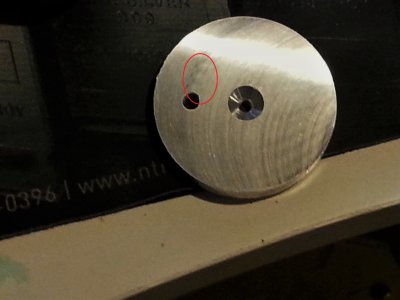- Joined
- Jul 4, 2014
- Messages
- 156
I bought a set of fly cutters for my mini-mill but never used them until today. Today I tried a test piece and I was very surprised by the finish I got. I am now hooked to fly cutters and I swear, I will never use an end mill if it can be done with a fly cutter.

Having said that I want to share a picture of what I observed. I had my fly cutter set to about 2 inch diameter and running at about 2400 rpm. The test piece I picked up had two holes as you can see. After the run I noticed one pf the holes had a kind of a shadow in the direction the cutter moved. If you will please see the picture where I have drawn a red oval around this area. You will see a series of round shadows of the hole radiating in roughly 1 O'clock direction from the hole. These shadows are only visible in certain conditions of lighting. They are not felt when I touch the surface by finger. I do not see this pattern as a defect but I am curious what may have caused this. Is it due to the tool vibration? My machine was G8689 Grizzly Mini-mill, unmodified version.
I milled the other side of the same disk at lower speed and I got better finish and no shadows.
Thank you for your comments to help me understand
Prasad

Having said that I want to share a picture of what I observed. I had my fly cutter set to about 2 inch diameter and running at about 2400 rpm. The test piece I picked up had two holes as you can see. After the run I noticed one pf the holes had a kind of a shadow in the direction the cutter moved. If you will please see the picture where I have drawn a red oval around this area. You will see a series of round shadows of the hole radiating in roughly 1 O'clock direction from the hole. These shadows are only visible in certain conditions of lighting. They are not felt when I touch the surface by finger. I do not see this pattern as a defect but I am curious what may have caused this. Is it due to the tool vibration? My machine was G8689 Grizzly Mini-mill, unmodified version.
I milled the other side of the same disk at lower speed and I got better finish and no shadows.
Thank you for your comments to help me understand
Prasad
